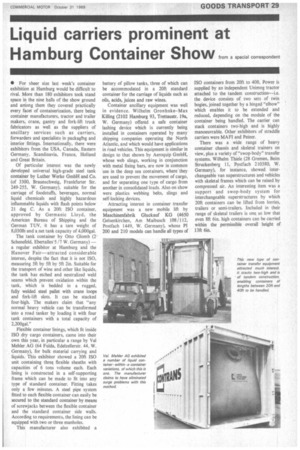Liquid carriers prominent at
Page 31

If you've noticed an error in this article please click here to report it so we can fix it.
Hamburg Container Show from a special correspondent
• For sheer size last week's container exhibition at Hamburg would be difficult to rival. More than 180 exhibitors took stand space in the nine halls of the show ground and among them they covered practically every facet of containerization, there being container manufacturers, tractor and trailer makers, crane, gantry and forklift truck fabricators as well as the suppliers of ancillary services such as carriers, forwarders and specialists in packaging and interior fittings. Internationally, there were exhibitors from the USA, Canada, Eastern Germany, Scandinavia. France, Holland and Great Britain.
Of particular interest was the newly developed universal high-grade steel tank container by Luther Werke GmbH and Co. (of 3300, Braunschweig, Frankfurter Str. 249-255, W. Germany), suitable for the carriage of foodstuffs, beverages, normal liquid chemicals and highly hazardous inflammable liquids with flash points below 21 deg C. As a 20ft ISO container, approved by Germanic Lloyd, the American Bureau of Shipping and the German TUV, it has a tare weight of 8,0301b and a net tank capacity of 4,000gal.
The tank container by Otto Glomb (2' Schenefeld, Ebertalles-5 /7 W. Germany) — a regular exhibitor at Hamburg and the Hanover Fair—attracted considerable interest, despite the fact that it is not ISO, measuring 5ft by 5ft by Mt 2in. Suitable for the transport of wine and other like liquids, the tank has etched and neutralized weld seams which prevent oxidation within the tank, which is bedded in a rugged, fully welded steel pallet with crane loops and fork-lift slots. It can be stacked four-high. The makers claim that "any normal heavy vehicle can be transformed into a road tanker by loading it with four tank containers with a total capacity of 2,200gal."
Flexible container linings, which fit inside ISO dry cargo containers, came into their own this year, in particular a range by Val Mehler AG (64 Fulda, Edelzellerstr. 44, W. Germany), for bulk material carrying and liquids. This exhibitor showed a 20ft ISO unit containing three flexible sheaths with capacities of 6 tons volume each. Each lining is constructed in a self-supporting frame which can be made to fit into any type of standard container. Fitting takes only a few minutes. A steel pipe system fitted to each flexible container can easily be secured to the standard container by means of screwjacks between the flexible container and the standard container side walls. According to requirements, the lining can be equipped with two or three manholes.
This manufacturer also exhibited a battery of pillow tanks, three of which can be accommodated in a 20ft standard container for the carriage of liquids such as oils, acids, juices and raw wines.
Container ancillary equipment was well in evidence. Wilhelm Gronhnke—Max Killing (2102 Hamburg 93, Trettaustr. 19a, W. Germany) offered a safe container lashing device which is currently being installed in .containers operated by many shipping companies operating the North Atlantic, and which would have applications in road vehicles. This equipment is similar in design to that shown by Aeroquip GmbH, whose web slings, working in conjunction with metal fixing bars, are now in common use in the deep sea containers, where they are used to prevent the movement of cargo, and for separating one type of cargo from another in consolidated loads. Also on show were plastics webbing belts, slings and self-locking devices.
Attracting interest in container transfer equipment was a new mobile lift by Maschinenfabrik Gluckauf KG (4650 Gelsenkirchen, Am Maibusch 108/112, Postfach 1449, W. Germany), whose PI 200 and 210 models can handle all types of
ISO containers from 20ft to 40ft Power is supplied by an independent Unimog tractor attached to the tandem construction—i.e. the device consists of two sets of twin bogies, joined together by a hinged "elbow" which enables it to be extended and reduced, depending on the module of the container being handled. The carrier can stack containers two-high and is highly manoeuvrable. Other exhibitors of straddle carriers were MAFI and Feiner.
There was a wide range of heavy container chassis and skeletal trainers on view, plus a variety of "swop-body" transfer systems. Wilhelm Thiele (28 Gremen, Beim Struckenberg 11, Postfach 210380, W. Germany), for instance, showed interchangeable van superstructures and vehicles with skeletal frames which can be raised by compressed air. An interesting item was a support and swop-body system for interchangeable superstructures by which 20ft containers can be lifted from lorries, trailers or semi-trailers. Included in their range of skeletal trailers is one so low that even 8ft 6in. high containers can be carried within the permissible overall height of 13ft 6in.


























































































































